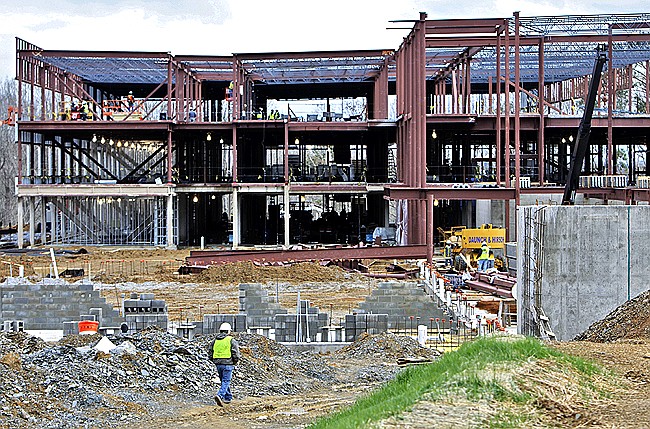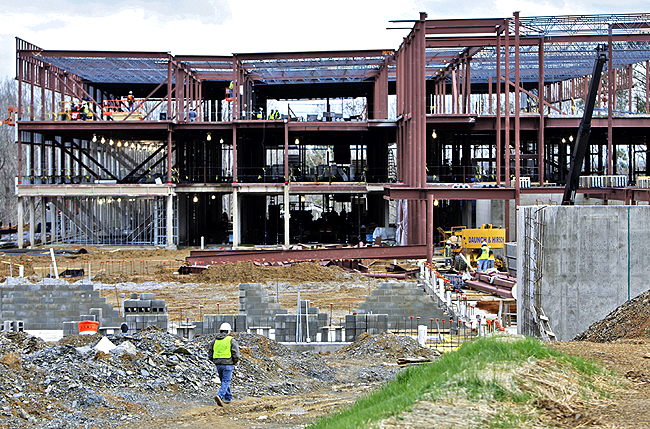The Dalton City School system spent about $300 more per pupil than the Georgia state average last year, while Whitfield County spent about $900 less than average per pupil.
The county ranks 151st out of 180 school districts in per-pupil spending during the 2010 fiscal year.
As unemployment hovers around 12 percent in the county, well above state and national levels, the two school systems have come under fire from local leaders for being unwilling to cut spending during tough economic times and for continuing to build new schools.
Dalton Mayor David Pennington has made references to a "school building bubble," and City Councilwoman Denise Wood talked about a "bloated" school administration that refuses to make cuts.
However, leaders from both school systems point to cuts they have made in the last two years, with Whitfield County cutting almost 12 1/2 percent from its budget in fiscal year 2011 on top of cuts in 2010, and Dalton cutting about 20 percent in 2010 and 2011 combined.
"The data proves that we are operating on a bare-bones budget," said Kenny Sheppard, chief financial officer for Whitfield County Schools. "We are managing our finances while still providing for the needs of the students."
City schools have an enrollment of about 7,000 students, while Whitfield County has about 13,400.
The discussion on spending has implications for every parent with a student in either school system, as well as anyone who lives in the county. If educators further cut spending, it likely will mean fewer teachers, more students per classroom and reduction in some services such as transportation.
Cuts that cancel building projects such as Eastbrook Middle School would require students to stay in deteriorating classrooms or be zoned for other schools.
Yet proceeding with plans to spend millions of dollars on new or upgraded school facilities or even maintaining current levels of spending could happen only by increasing either sales taxes or property taxes, a move some local officials say would be disastrous to the fragile local economy.
Spending comparisons
The Dalton City Schools system has decreased spending per pupil each year over the last three years but still spent more than the state average each year. It spent $9,043, ranking 56th out of 180 school districts in the 2010 fiscal year, which runs July 1 to June 30.
Whitfield County spent $7,887 per child and fell below the state average in spending in almost every category, including school administration, pupil services, transportation and maintenance, according to figures provided on the Georgia Department of Education website.
Jim Hawkins, Dalton City Schools superintendent, said data must be put into context to be properly understood.
"You have all these people saying things, and conclusions are based on perceptions," Hawkins said. "But without a context, you don't know if it is a good or bad number."
City schools officials compare their numbers in three ways, he said. They benchmark against the previous years, they compare their budgets to surrounding school districts and they compare budgets with districts of similar size and economic level.
Those numbers can be different than state averages and represent systems similar to Dalton's, said Deana Farmer, spokeswoman for city schools.
Both school systems spend more than the state average on instruction, putting almost 70 percent of their operating budgets into teachers' pay and benefits and direct classroom expenditures. In that category, Dalton ranked 51st in the state and Whitfield County ranked 65th, figures show.
Dalton schools spent more than average in almost every category except for school administration, which covers the salaries of principals, clerks and secretaries. Dalton ranked 161 out of 180 schools in the same category.
One of the most marked differences between the two schools was in general administration spending - the salaries for the superintendent's office and other operating departments. Dalton City Schools spent 7 percent in that department in 2010, ranking 24th in the state.
On the other hand, Whitfield County cut its general administration budget by almost 18 percent from 2010 to 2011. At 2.7 percent, it ranks 130th in the state.
According to the state website that provides salaries for employees, Hawkins earned $190,424 in 2010, while Whitfield County Superintendent Danny Hayes made $112,875.
Spending cuts
Both systems insist that they have made deep cuts in the last three years and expect to make further cuts in the 2012 budget now being put together.
Dalton schools cut $5.5 million in 2011 - leaving a general fund budget of about $56 million - by reducing the school year by five days, implementing pay reductions and by imposing a hiring "chill."
"This was not an expenditure problem, it was a revenue problem," Hawkins told the city school board several times during a budget discussion Friday. "It is solely a revenue shortfall issue."
Whitfield County used similar measures, going from a budget of almost $108 million in 2010 to $94.5 million in 2011, while enrollment remained almost steady or increased slightly.
Revenues from state and local levels have fallen and are expected to continue to drop, according to numbers provided by Eric Beavers, spokesman for Whitfield County schools. In addition, the schools received more federal money from 2009 to 2011, but will not in 2012.
New buildings
Pennington also has pointed out that many of the schools are not filled to 100 percent capacity. According to numbers from the Georgia Department of Education website, several elementary schools in Dalton are at 60 to 70 percent capacity, while the high school was at 74 percent capacity before the addition was built.
The only exception is Dalton Middle, which is filled to more than 100 percent capacity this year.
Hawkins argued that those numbers do not accurately reflect the situation in each school. In compiling capacity figures, the Department of Education does not consider pre-k students, special purpose classrooms or those used for special education, he said. It is strictly a number determined by looking at total size if every single classroom were filled.
Their system estimates about 90 percent of absolute capacity to determine an approximate number, Hawkins said, which is "closer to reality."
Capacity numbers were not available for Whitfield schools, due to differences in reporting numbers, but enrollment numbers and square feet per school show the county schools have more students per square foot than the city schools.
Last week, the Whitfield County Board of Education voted 3-2 in favor of rebuilding Eastbrook Middle School at an estimated cost of $24 million. It also expects to open the newly built Coahulla Creek High School this fall, which is being built for a bid of $45.2 million.
Dalton City Schools added 84,000 square feet onto Dalton High School last year.
To fund the Eastbrook building project, county schools may ask for voters to approve a 1 cent education special project local option sales tax - an ESPLOST - in November. The ESPLOST already is in place, but must be renewed by vote.
Dalton city schools would have to agree to the request and would get part of the money, but have not said what they plan to do.
During Friday's meeting, officials discussed the possibility of building a new middle school, but agreed to first look at rezoning the schools to redistribute students into classrooms that are not filled.
Pennington, who has no authority over either school system, said he thinks the tax would be a mistake for the county and negatively would impact the local economy.
One of the solutions to school capacity numbers would be to move Eastbrook students to schools in the city and county that are not filled now, Pennington said.
"We don't need to be spending money taxpayers just don't have," he said. "We need to be looking at the extra space we already have to see how we can handle this."

